Abstract
Rural migrants, who are widespread in China, experience diverse production and living needs upon resettlement in towns because of their various population attributes. However, the planning of resettlement community public spaces solely follows urban community function programming, which is misaligned with rural migrants’ needs, leading to a conflict between migrants and community regulation. Under the architectural planning theory and founded on previous research about rural migrants’ needs by the authors, this study involves expanded research that explores an approach to transforming migrants’ needs into resettlement community public space function programming. This approach includes three steps: (1) judging the dividing line between high and low levels of migrants’ needs, (2) extracting “Basic–Expansion–Potential” function item sets from the permutation and combination of different migrant types, and (3) calibrating function item sets with the current national architecture standard. In addition, this study compared the transformed data results with the need characteristics of migrants to inspect the rationality of the research method, formed two types of resettlement community public space function programming, namely “medium-high” and “medium-low” urbanization resettlement communities, and proposed elastic design strategies to respond to the complex functional programming. This research will provide a theoretical reference for the planning and construction of such resettlement spaces in China as well as other countries with the same migration and resettlement situation.
1. Introduction
1.1. Mismatch of “City-like” Resettlement Community Public Space Function Programming and “Rural-like” Migrants’ Production and Living Needs
Migration caused by regional construction, ecological exploitation, and climate change promotes the progress of human society [1]; however, rapid urban development has resulted in involuntary migration, creating a demand for resettlement [2]. Over the past decades, countries at different levels of development have contributed to global development. Numerous regional revitalization strategies and programs have been established, and many of them involve resettlement [3]. Various resettlement methods, including land resettlement, secondary and tertiary industry resettlement, and monetary resettlement, have emerged around the world [4]. Since the rapid urbanization of China in the 1980s, rural lands have been expropriated and reintegrated into construction land, inducing widespread “rural migration” [5]. In 2018, for instance, Zhejiang Province in China witnessed the displacement of 1,400,479 rural migrants because of water conservation projects. Different regions in China have different resettlement guidelines for rural migrants. In economically developed and highly urbanized areas, such as the Yangtze River Delta in eastern China, where land resources are scarce, local governments have adopted a production resettlement method. This approach offers rural migrants the opportunity to participate in secondary and tertiary industries through technical training while enabling them to engage in agriculture by renting land in nearby villages [6]. For resettlement, the local government primarily focuses on planning plug-in-town resettlement communities that adhere to an urban model and are situated within the town’s land inventory, which can share public services and other resources with surrounding communities [7]. Unlike the spontaneous environment of the rural settlements where rural migrants originally lived, plug-in-town resettlement communities are constructed following clear standards and norms [8]. These standards forbid production activities and guarantee living functions, including administrative management, medical and health care facilities, recreational amenities, elderly care, childcare services, and green landscapes [9,10], creating a “city-like” public space environment.
However, rural migrants generally lack the experience and skills to sustain themselves in urban and town environments, posing significant obstacles to the implementation of the production resettlement method. The production space is taken away from the resettlement community, resulting in the loss of material resources for production activities and the destruction of livelihood mechanisms for rural migrants [11]. In addition, the collapse of traditional rural settlement structures and the disappearance of characteristically rural spaces, where production and living space are interwoven organically, have created a disparity between rural migrants and urban residents with respect to their cognition and use of resettlement community public spaces [12,13]. Spaces intended for fitness, leisure, and entertainment are occupied by production activities, such as food drying and crop processing; agricultural tools and vehicles can be seen everywhere; and public green spaces are converted into small vegetable fields. This type of “rural-like” space heterogeneity is constantly corrected by community regulation because it violates urban community management methods. Moreover, conflicts between community workers and migrants frequently occur, posing a threat to the harmony, stability, and high-quality lifestyle of rural migrants within the resettlement community [14,15]. Exploring the internal mechanism of contradiction and providing China’s practical experience as a reference for other developing countries and regions is undoubtedly a main way for China to make a greater contribution to humanity [16]. The root cause of this conflict is the inability of the function system in resettlement community public spaces to adequately address the complex production and living “needs” of rural migrants. To create a high-quality living environment for rural migrants and promote the harmonious and stable development of resettlement communities, a “function programming” of resettlement community public spaces suitable for the “needs” of rural migrants needs to be established.
The evaluation and cognition of rural migrants’ needs form the basis for constructing suitable function programming. To understand their needs, the authors have already proposed distinct categories for the production and living needs of rural migrants by analyzing their behavior and the spatial heterogeneity of resettlement communities in previous research [17] and constructed a “production–living” need coupling model framework (Figure 1) that reveals the existence of four different types of rural migrants—Type H-H, Type H-L, Type L-H, and Type L-L—based on their needs derived from environmental–behavior theory (Appendix A) [18].
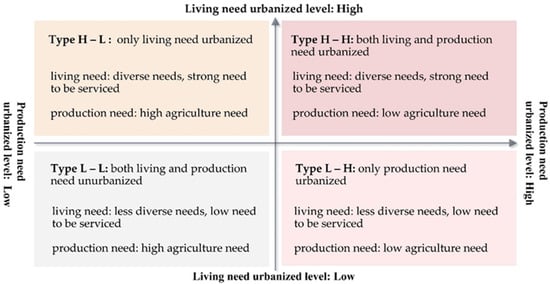
Figure 1.
Model framework of production and living needs characteristics of rural migrants.
Function programming is structured based on rural migrants’ needs; however, a complex translation mechanism exists [19]. The three most important aspects are as follows:
- The need level reflects the priority of indicators to be satisfied. Therefore, finding the line between high- and low-need level is necessary to identify the high- and low-need indicators for the four migrant types [20].
- The needs of a single migrant type can be directly translated into function programming with priority classification; however, the functional programming of resettlement community public space should be universal to a certain extent [21]. This means that, considering the arrangement, combination, and output of the needs of the four migrant types, function programming with priority classification suitable for multiple types of migrants should be established.
- Needs resulting from the subjective perspective of users are often limited due to their experiences. For example, important safety facilities such as disaster prevention will be classified as low priority if migrants do not adequately consider disaster safety. Therefore, correcting the function programming structure based on needs with current norms is vital [22].
In addition, resettlement communities typically comprise different migrant types, necessitating a function programming that considers the composition of the population and extracts the needs characteristics for these groups [23]. Based on the rural migrants’ production and living needs shown in Appendix A of the authors’ previous research, this research proposes a scientific method to convert needs into function programming, providing support for the construction of resettlement community public spaces that are suitable for rural migrants. The research design framework is shown in Figure 2.
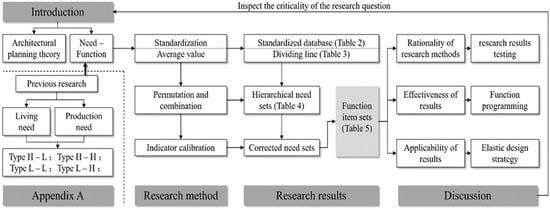
Figure 2.
The research design framework.
1.2. Function Programming of Resettlement Community Public Space Research Based on Architectural Planning Theory
Research around a problem tends to have hermeneutic or practical different tendencies due to its unique goals and meanings [24]. Hermeneutics centers on social rationality and endeavors to uncover internal laws and mechanisms through the study of phenomena. Its objective is to gain a deeper comprehension of the inherent cultural significance associated with specific phenomena [25]. Practical research focuses on causal rationality and proposes a methodology system based on the internal laws and mechanisms identified through hermeneutic research [26]. To some extent, the interaction between the built environment and the user reflects the intention of a specific social environment. Sustainable adaptation [27], subjective well-being [28], and research around this field primarily rely on hermeneutics principles. However, spatial planning requires a clear planning scheme after understanding space users’ intentions and is a practical translation based on the research results of hermeneutics [29]. To support this translation, hermeneutics should give externalization measurable data as the research result. Some research methods from sociology and anthropology can provide references. Such methods usually first make the problem of a specific phenomenon into a research concept and then use a structured fieldwork or interview questionnaires to convert empirical research results into measurable data for further practical research [30]. The research objective of this study is to propose space design decisions based on the previous hermeneutics research results of the interaction between environment and people. Architectural planning theory, on the one hand, obtains patterns and habits of human life by explaining a specific social phenomenon, and on the other hand, feeds back the life patterns and habits under hermeneutics research to the new space design, so as to improve the planning and feasibility of the actual design project [31]. This theoretical connotation is consistent with the research objectives of this study and therefore is the main theoretical basis of this study.
Architectural planning theory includes several aspects, such as influencing stakeholder decisions, mining subject features, and translating subject features to design requirements [32]. For example, Yong Lu provides a sustainable development path for Chinese traditional villages from a heritage protection perspective by analyzing the constraints and cooperative relations of multiple stakeholders [33]. Ziqi Zhang proposes the construction principles of a rural age-appropriate environment from the users’ perspective by analyzing the use pattern and spatial preference [34]. Qiu zhi analyzed the coupling relationship between demand and use frequency of rural public service facilities from the perspective of villagers in research in northern Zhejiang [35]. Under the migration and resettlement topic, relevant stakeholders involved in resettlement community planning include top-down local governments, design enterprises, and bottom-up rural migration, which shows that leading it inevitably involves complex stakeholder determination and the transformation of stakeholder features into design strategies [36]. However, due to strong top-down government intervention in China’s urbanization development, decision making in resettlement community planning is predominantly influenced by governments and design enterprises, often diminishing the interest of rural migrants, resulting in the almost complete compliance of the current resettlement community planning decisions with established urban regulations [37]. With regard to architectural planning theory, this study first extracts the stakeholder that has been weakened in the current resettlement planning decision making, rural migrants. At the same time, based on the authors’ previous hermeneutics research results of the characteristics of rural migrants’ needs, this study excavates the translation mechanism of the migrants’ needs to function and proposes a functional programming based on rural migrants’ needs, so as to provide a basis for practical research on the spatial planning of resettlement communities. In addition, this study will further consolidate the theories of architectural planning.
2. Materials and Methods
2.1. Value of “Need-Function” Translation
2.1.1. Relationship between Rural Migrants’ Needs and Function Programming of Resettlement Community Public Spaces
Studies on space planning from the users’ perspective mainly focus on the interrelationship among the physical space environment, behavioral patterns, and cognitive patterns. The research process generally involves two key steps [38]. First, by researching external behavior and need characteristics in existing space environments, hermeneutics research yields insight into the underlying internal logic of complex space phenomena. Subsequently, through adjusting, discarding, and supplementing, the hermeneutic research result is transformed and applied to suitable space planning to support practical building [39].
For resettlement community planning research under rural migrants’ needs, this study established a mirror model from the cognitive input of “planning space-adapted use behavior-migrants’ needs,” based on existing phenomena, to the output of the future spatial plan of “function programming-replanning space supportive behavior” (Figure 3). In this mirror model, the authors have already finished the research in the input part and obtained rural migrants’ need characteristics and data, which is the hermeneutic research. The translation of rural migrants’ needs to function programming of resettlement community public space is an important step of hermeneutic to practical research. It is also the key problem being discussed in this paper. With the research result of this paper, further research on the output part about space planning according to function programming can be carried out.
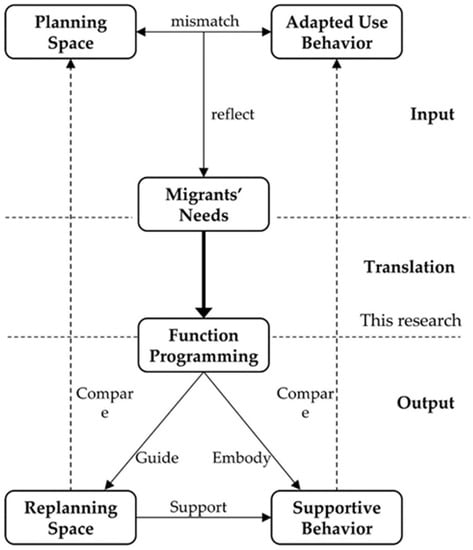
Figure 3.
Research positioning under the mirror model from “behavior-space-need” to “function–space-behavior”.
2.1.2. Need Characteristics and Data of Rural Migrants
Using the mirror model, the authors aim to conduct a serial study that includes all three parts of input, translation, and output. This study mainly focuses on the transformation from need to function, so it is necessary to first obtain the need characteristics and data of rural migrants as the material and foundation of this study, which are also the research results of the input section. For this part, the authors have already conducted a two-step study on the “behavior” and “need” of rural migrants in the sample plug-in-town resettlement community L in Zhejiang Province, China, and the research results have already been published. The two research results revealed significant insights into the characteristics of rural migrants’ needs. (1) The first step starts with the wide spread of adapted use behavior in the public space and finds that rural migrants’ needs are reflected not only in the living space “occupied and transformed by rural-like living activities” but also in the space “requisitioned for production activities.” Furthermore, the migrant population presents aging characteristics [17]. (2) The second step is based on behavior research. It constructs a “production–living” need analysis dimension, conducts a need questionnaire survey with elderly migrants in resettlement community L, and establishes a coupling model based on production and living needs through systematic clustering and chi-square analysis [18]. This model reveals the differentiated characteristics of production and living needs of elderly migrants with different population attributes, reflecting their complex urbanization level; that is, some migrants are less urbanized in production and thus exhibit a strong need for production factors that can “obtain economic income,” while some migrants are highly urbanized in terms of living factors and thus have diversified demands for public service facilities.
As the third step, this study mainly uses the results on rural migrants’ needs from the second step. This study aims to find the translation approach of “need” to “function programming” and obtain a suitable function programming for the planning of plug-in-town resettlement community public space. This study still considers resettlement community L, where “the adaptation and transformation of migrants to the urban environment has been stable”, as mentioned in the previous behavior and needs study, as the research object. Community L is located in north Zhejiang province in China, where there is a relatively high urbanization level. The community is constructed on residential land and planned following the urban community building regulation, and its space is made up of apartment blocks and some street stores. There is a town east of the community, and there is farmland west of the community. The overall appearance of community L is as shown in Figure 4. Active migrants share similar characteristics of “rural-like” production and life needs, and there are four different types.
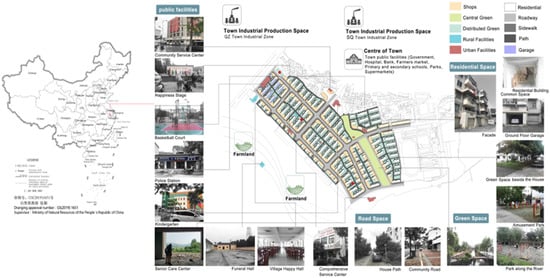
Figure 4.
The overall appearance of community L.
As this study mainly focuses on the overall functional programming of resettlement community public space, the study object of “production-living” need has been expanded from elderly migrants to active migrant inhabitants in public space. To obtain data related to rural migrants’ needs, a quantitative investigation was conducted.
- 1.
- Questionnaire design
For rural migrants’ needs, this study investigates not only the living aspects reflected in “public space occupied and transformed by rural-like living activities” but also the production aspects reflected in “public space requisitioned for production activities.” Therefore, this study employs a dual-dimensional “production–living” system with 26 indicators across 6 aspects, including health care, living care, cultural entertainment, spiritual consolation, agriculture, and handicraft business, as the basis for investigating rural migrants’ need characteristics. The need degree of rural migrants for each indicator was measured using a 5-point Likert scale, where ratings of 5, 4, 3, 2, and 1 correspond to very high need, high need, indifferent, low need, and very low need, respectively.
- 2.
- Rural migrant sample definition
The research on rural migrants’ needs is led by the adapted use of resettlement community public space; it is found that most subjects of adapted use in public space are active migrants whose main daily activities are walking, chatting with each other, and working in the community. Compared with workmen who are always outside in the community or less active migrants who are usually limited to indoor spaces due to lower cognitive and activity abilities, the active migrants’ needs are comprehensive in terms of health care, economy, entertainment, dignity, and value realization. As this study aims to conduct a comprehensive survey of production and living needs at the community level, the questionnaire investigation primarily focuses on active migrants who can independently engage in public spaces.
- 3.
- Sampling method
To obtain real samples of “active migrants” in the public space of resettlement community L and infer the overall migrants’ needs based on these samples, this study extracts six survey partitions in community L using a general random sampling method of “fixed point acquisition + equal distance” in social surveys. In each survey partition, a compound collection method of “centralized site + regional roaming” is employed (Figure 5). To ensure accurate data collection, any respondent who failed to understand the questionnaire despite repeated communication was excluded by the investigator.
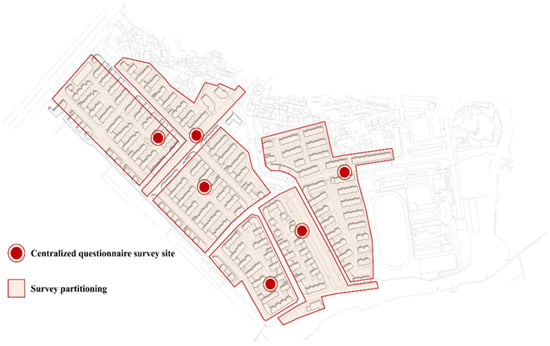
Figure 5.
Survey partitioning based on “equal type–equal distance”.
- 4.
- Date and time of survey
The survey was conducted by a 12-person research team on a working day and a rest day in early July 2018, when the weather conditions were suitable for outdoor activities. In the presurvey, it was found that 5:00–7:00, 9:00–11:00, 15:00–17:00, and 17:00–19:00 are the peak hours of the outdoor activities for migration. Therefore, they are the concentrated periods of formal questionnaire distribution.
- 5.
- Sample characteristics and data
A total of 125 valid questionnaires were obtained. By analyzing the average score of the samples, clustering characteristics of high and low needs for migrants were found in the production and living dimensions. Thus, further classification of the samples was needed. To explore the comprehensive differences in the production and living need dimensions of different types of samples, a three-step analysis path comprising grouping, correlation, and construction was performed using SPSS 23.0 for Windows. The 125 active rural migrant samples show similar characteristics of “rural-like” production and living needs characteristics, and they are divided into four different need types. The classification of the 125 samples is the main content of the second step of the research on “need”, so the specific classification process and classification results are included in Appendix A.
This study focuses on the characteristics of typified migrant needs rather than exploring individual needs. Therefore, the average score of all samples in a certain type of migrant for a certain need indicator is used as the value for that migrant type need for that indicator, and the need data of 26 indicators for each of the four types are used as the basic data for functional programming construction. The distribution characteristics of need data of four types are shown as a line chart in Figure 6. Type H-H and Type H-L generally have relatively higher and diverse needs for daily life; Type L-H and Type L-L only have a high demand for a small number of living indicators; the demands for cultural halls, paths between houses, and sidewalks among the four categories of migrants are all relatively high; for production need, Type H-L and Type L-L have a higher demand for agriculture and a lower demand for handmade and business; Type H-H and Type L-H only have a high demand for vegetable gardens in terms of production.
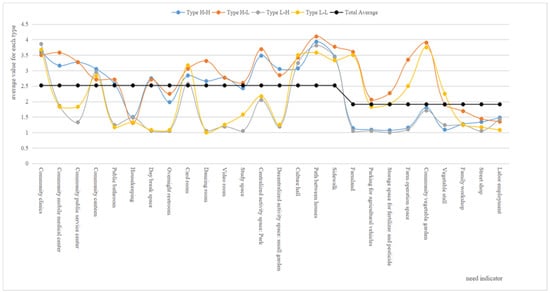
Figure 6.
Average need value distribution of the original data.
2.2. Approach to “Need-Function” Translation
To address the intricate constraint condition in translating the diverse needs of multiple types of migrants to functional programming structures, this study proposes a comprehensive translation approach comprising the following four steps.
2.2.1. High- and Low-Need Level Dividing Lines Determined for Multiple Types of Migrants
The need judgment criteria include intermediate and average values. While our need questionnaire was designed as a 5-point Likert scale, the median value of 3 theoretically can be regarded as the standard for high- and low-need level dividing lines. However, rural migrants often express their needs at a lower level due to concerns about economic conditions, environmental quality, and other aspects. For example, comments such as “Who will pay for it?” and “A vegetable patch in front of a house is wonderful, but the city managers will not let us have one” were frequently heard during this study. Given that the migrants’ needs evaluation generally tends to be lower than their real attitudes, the average value can better represent the needs than the median value. In addition, due to differences in values between the four types of migrants, migrants with lower levels of needs are easily overlooked. Therefore, different types of migrants’ needs are not comparable, and the results should be standardized before being translated into function programming. According to the linear characteristics of mathematical functions, normalization standardized methods mainly include min–max conversion, Z-score conversion, exponential function conversion, logarithmic function conversion, and arctangent function conversion. This study aims to extract appropriate high-need options by comparing the needs distribution of the four migrant types. This means that the standardized data should also retain the distribution relationship of the original data; therefore, the min–max method with fully mapped data distribution is selected in this study. Notably, the min–max method has a limitation: changes in data may lead to changes in maximum and minimum values. However, as the migrants have already been classified, an increase in the sample size of the same migrant type will not cause a subversive influence on the minimum or maximum results for that type.
2.2.2. Function Item Set Extraction Based on the Permutation of Multiple Types of Migrants
Rural migrants’ need cognition presents different trends; however, some overlaps still exist. After permutation and combining the standardized need data, the “overlap set” and “difference set” of different types of migrants’ needs are obtained. Indicators above the dividing line in the “overlap set” represent the common high needs of different types of migrants and are extracted as the “basic need set.” Indicators below the dividing line in the “overlap set” represent the common low needs of different types of migrants and are extracted as the “potential need set.” The “difference set” represents a higher need for specific types of migrants and is extracted as several “expansion need sets” (Figure 7). Different priorities should be given to different need sets in the function programming of resettlement community public spaces.

Figure 7.
Transformation framework for the need-function.
2.2.3. Function Item Set Calibration Based on Current Building Standards
From a subjective perspective, individuals may have limited awareness of environmental crises and low familiarity with certain specific facilities, which can impact the accuracy of subjective needs research results [40]. For example, some necessary safety functions, such as disaster prevention, refuge facilities, and administrative service facilities, tend to be low-need functions. From a universal application perspective, further calibration based on the current construction norms of functional programming is necessary to effectively promote docking migration needs in a real environment and implement research results. At present, in urban community planning in China, the Code of Urban Residential Areas Planning and Design (GB50180-2018) serves as the fundamental reference. This study also draws from it and incorporates the requirements for community-level public service facilities within the “five-minute core living circle”.
For the function programming of urban residential community public space, China’s current building standard, the Code of Urban Residential Areas Planning and Design (GB50180-2018), presents a four-hierarchical supporting scheme for the living circle. This scheme includes the function programming content of a 15 min living circle, a 10 min living circle, a 5 min living circle, and the living neighborhood. In this scheme, the function programming of the 5 min living circle and residential neighborhood aligns best with the “community public service demand.” Therefore, the function programming of the 5 min living circle and residential neighborhood level is extracted as the content of correction. In addition, based on the nature of land use, the public space listed in the Code of Urban Residential Areas Planning and Design (GB50180-2018) includes green space and traffic space, except for community service facilities. Therefore, for the living dimension, the subcategories are divided into residential neighborhood-level functions and community service facilities, green spaces, and traffic spaces within the 5 min living circle. The production dimension can be divided into three subcategories based on industry: commercial space, industrial space, and agricultural space. However, these functions are not supported within the 5 min living circle. Finally, the function programming of urban residential community public space is summarized as the “five-minute core living circle” in Table 1.

Table 1.
Function programming of urban residential community public space: “five-minute core living circle”.
3. Results
3.1. High- and Low-Need Level Dividing Lines Determined for Multiple Types of Migrants
3.1.1. Establishing a Standardized Database
Using the min–max standardization method, the original average value of the need indicator was defined as “mij,” in which the subscript “i” is defined as 1, 2, 3, and 4, representing Type H-H, Type H-L, Type L-H, and Type L-L migrants, respectively, and the subscript “j” represents the subscript in the need indicator “Xj.” The average standardization value of the need indicator for the four types of migrants is defined as “Mij,” calculated according to the following formula:
where {mi} is defined as the set of all original average values of the need indicator of class “i” type, while max{mi} and min{mi} are the maximum and minimum values of this set, respectively. The standardized database of rural migration needs obtained through calculations is listed in Table 2.

Table 2.
Standardized database for rural migrants’ needs.
3.1.2. Extracting High- and Low-Need Level Dividing Lines
Based on the standardized need database and combined with the principle of separate judgment of production and living needs, the standardized average of living needs is 0.50, and the standardized average of production needs is 0.24. For each type of rural migrant with different need characteristics, need indicators with standardized values above the average value were judged as urgent function items and those below the average value were judged as nonurgent function items. In this way, the need indicators are classified into priority categories for each type of migrant, which is the “need-function programming” basic transformation model (Table 3).

Table 3.
“Need-Function programming” basic transformation model.
This model reflects that among the 26 production and living need indicators, there are common urgent and nonurgent function items for all migrant types, and other items are only urgent for some types: (1) Common urgent function items cover almost every aspect of living and production needs, such as health care, living care, cultural entertainment, spiritual consolation, and agriculture, indicating that “rural-like” is to a certain extent the need characteristic of the whole migrant population. (2) The differentiated needs of migrants in production differ from those in living. Type H-H and Type H-L, which exhibit higher levels of urbanization, have more diversified needs in health care, living care, and cultural entertainment. However, Type H-L and Type L-L, with lower levels of urbanization, show a greater need for agriculture, and Type L-L needs a handmade and business item (vegetable stall). Moreover, (3) all four types of migrants have low demands for some living service items and some more advanced industrial and commercial production items, which can be categorized as nonurgent.
3.2. Function Item Set Extraction Based on Multiple-Type Migration Permutation
The study permutation combines four sets of migration needs, which are classified by the urgency degree that needs to be met. Five sets, including the “overlap set” and “difference set,” are obtained. The overlap set with common urgent function items is defined as the “basic need set.” Similarly, the overlap set with common nonurgent function items is defined as the “potential need set.” The difference set with function items that are only urgent for some types of migrants is defined as the “expansion need set.” (Table 4).

Table 4.
“Basic–Expansion–Potential” function item set extraction process.
The “basic–expansion–potential” function sets organize indicators based on the “urgency degree” rather than the “function type,” providing the foundation for the establishment of functional programming. This programming ensures that urgent needs are prioritized. The specific contents and functions of the five sets are as follows:
- Basic Need Set: This set includes indicators that mainly guarantee the physiological and psychological satisfaction of basic living for rural migrants and the reconstruction of social relationships after relocation.
- Expansion Need Set 1: This set includes function items needed only for Type H-H and Type H-L. The indicators cover health care, living care, and cultural entertainment indicators, reflecting that some migrants have already transitioned to an urban lifestyle and seek high-quality public services.
- Expansion Need Set 2: This set includes urgent function items needed only for Type H-L and Type L-L in agriculture. Notably, small-scale planting, such as vegetable gardens, is preferred by every migrant type, which differs from large-scale planting, such as farming, which requires a complete process and complex supporting facilities. Only low-production urbanized areas exhibit a need for large-scale planting.
- Expansion Need Set 3: This set focuses solely on the vegetable stall and is an urgent need only for Type L-L. The difference between Type H-L and Type L-L reflects that some migrants aim to increase economic income by “commodifying” agricultural production gains, whereas others view the gains as a fresh food supplement to their daily diet.
- Potential Need Set: This set represents an overlap set with common nonurgent function items.
3.3. Function Item Set Calibration Based on Current Building Standards
This study corrected the above function item sets according to China’s current urban residential district building code “standard for urban residential area planning and design (GB50180-2018),” especially the content regarding community planning. The correction follows two principles:
- Put functions clearly designated as “should” construction in GB50180-2018 into the “basic model” of function programming;
- Put functions clearly indicated as “appropriate” construction in GB50180-2018 into the “expansion model” of function programming.
After correction, the function sets are as follows:
- In the “Basic Need Set,” for multi-dimension guarantee, aspects of environmental protection, education, and transportation facilities, which were unexamined in the questionnaire but are mandatory requirements, were added. The public service center, canteen, park, and small garden in “Expansion Need Set 1” were replaced in “Basic Need Set” because they are marked as “should have” in the standard.
- After removing indicators, the “Expansion Need Set 1” contains items in health care, living care, and cultural entertainment, but its specific indicators are reflected as public service elements with better quality improvement. The corrected module is defined as “Expansion Need Set A.”
- Considering that vegetable stalls in “Expansion Need Set 3” can flexibly utilize public spaces such as roads and squares in the community, designing them independently is not necessary. Therefore, it is combined with “Expansion Need Set 2” to form a new “Expansion Need Set B,” which includes supporting space around agricultural production.
- The “Potential Need Set” content remains unchanged, which is still a set with common nonurgent function items.
- See Table 5 for “Basic–Expansion–Potential” functional item sets after correction.
 Table 5. “Basic–Expansion–Potential” function item sets after correction.
Table 5. “Basic–Expansion–Potential” function item sets after correction.
4. Discussion
4.1. Can the Transformed Data Result Still Reflect the Need Characteristics of Migrants: The Rationality of the Research Method
The functional programming construction of this study aimed to transform soft human emotional expression into hard physical indicators in spatial design through mathematical methods, which involves multiple mathematical methods such as data standardization, permutation and combination, and indicator calibration. The application of these mathematical methods has to some extent changed the characteristics of the original need data, so it is necessary to explore whether the transformed data can still reflect the needs of migrants.
(1) Standardization of need data.
The standardized mean value of each need of the four types of migrants was illustrated using a line chart to analyze the data distribution characteristics more intuitively (Figure 8). From the figure, it can be seen that Type H-H and Type H-L generally have relatively higher and diverse needs for daily life; Type L-H and Type L-L only have a high demand for a small number of living indicators; the demand for cultural halls, paths between houses, and sidewalks among the four categories of migrants is relatively high; for production need, Type H-L and Type L-L have a higher demand for agriculture and a lower demand for handmade and business; Type H-H and Type L-H only have a high demand for vegetable gardens in terms of production. The above need characteristics are consistent with the line chart analysis of the original need data of migrants shown in Figure 6. It reflects that the standardized data preserve the characteristics of the original mean well and can accurately reflect the coupling relationship between the production and living need of migrants.
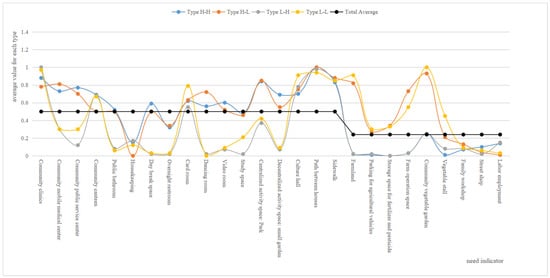
Figure 8.
The standardization data distribution characteristics of the need indicators.
(2) Permutation and combination.
Through the permutation and combination of the needs of different types of migrants, five high and low need sets were extracted, in which the high-need set can be seen as providing guaranteed basic living function, whereas the low-need set includes function items that are not frequently used. With these function characteristics, these need sets can be defined as function item sets. The need characteristics of most migrants are consistent with the function item sets, but there are also cases in which the need characteristics of a small number of migrants are opposite to the function item set. Especially for potential need indicators, although most migrations do not need these indicators, several individuals have a high need for them. For example, an elderly bun shopper expressed a high need for a street shop because he felt that the work brings achievement and described the challenges of being self-employed.
(3) Indicator calibration.
According to the principle of calibration, the calibrated high-need set includes more indicators, which will lead to the function configuration items established based on this set exceeding the actual migration needs to some extent. Although this transcendence may lead to a certain degree of resource waste such as idle public space, some relevant studies believe that moderately exceeding the current needs of residents in public services is beneficial for the sustainable development of communities and provides environmental conditions for diverse community activities.
4.2. Is the Function Programming Suitable for Multiple Types of Migrant Combinations: The Effectiveness of the Research Results
The goal of this study was to propose a set of function programming that can be applied to spatial design according to the migrants’ needs, so it is necessary to evaluate the effectiveness of the transformed results. The result is a set of hierarchical functional item sets that can reflect the urgency of the need to be satisfied. So, its applicability lies in whether a certain indicator is an essential item or an optional item in the spatial planning according to this set of function programming. The Essential Part should be guaranteed in resettlement community public space planning, and the Optional Part can be conditionally allocated according to migrants’ type differences and the dynamic development of migration needs.
The extraction of functional item sets is based on the permutation and combination of the four migrant need sets in which urgent or nonurgent indicators have already been classified. Therefore, all need indicators in the same set have the same urgency to be satisfied. Therefore, the urgency trait of need indicators in the same set can be converted to the set as the overall characteristic. According to the overall characteristics of the set, we can judge the set that includes urgent function items of a certain migrant type that is considered the “Essential Part” for that specific type, while the set that includes nonurgent function items is considered the “Optional Part”. The calibrated set can be seen to have the same properties as the non-calibrated set, which leads to the essential or optional properties of the corrected functional item set for each migrant type also remaining unchanged compared with the non-calibrated set. In order to adapt to the calibrated set, extended need set 2 and extended need set 3 will be merged, and Table 6 shows the judgment process.

Table 6.
Function programming for single-type migrants.
A resettlement community generally contains various types of migrants. Therefore, when implementing function programming for a single type of migrant in the public space planning of the resettlement community, the overall functional programming framework should be organized based on actual types of migrants [41]. According to the classification of production and living needs, the types of migrants are shown as Type H-H, Type H-L, Type L-H, and Type L-L. So, there are in total fifteen population composition patterns, including four patterns of single type, six patterns of two types, four patterns of three types, and one pattern of all four types (Table 7). The Essential Part of a pattern reflects the degree of urbanization of the resettlement community. When the Essential Part is “Basic set” or “Basic set + Expansion set A,” the migrant group has a low need for production, and its rural-like characteristics are mainly reflected in rural collective memory continuation, which can be defined as a “medium-high urbanization resettlement community.” However, when the Essential Part includes “Expansion set B,” the rural-like characteristics of the migrant group are mainly reflected in the need for a complex space of production and living, which can be defined as a “medium-low urbanization resettlement community.” Among all patterns, the “medium-low urbanization resettlement community” accounted for 75% of all types, indicating that the complex “rural-like” demand characteristics of the migrant group after migration should not be ignored in the function programming plan for resettlement community public space.

Table 7.
Function programming for resettlement community.
4.3. How does Space Design and Planning Respond to Functional Programming: The Applicability of the Research Result
The “Essential + Optional” function programming patterns require a compound function and diversified role conversion in the space planning. For this complex design, “elastic design strategy” is considered an effective response [42]. Regarding the specific meaning of elastic, implementing function items into the public space planning of a resettlement community is not simply about “increasing” space for each function indicator. It involves perceiving the space as a human settlement system and planning and designing it through the organization, overlap, and separation of function items and forming a suitable “elastic space” to support the diversified production and living behaviors of rural migrants. In the medium-high urbanization resettlement communities, the design can simply take the retention of rural collective memory into consideration based on the basic urban community public services [43]. However, for the more extensive and complex “medium-low urbanization resettlement community”, putting forward a set of systematic elastic design strategies is necessary. Based on the basic principles of residential planning and design, this study puts forward an elastic design strategy from three aspects.
4.3.1. Adopting Moderate Planning in Land Use and Road Structure
The existing community planning standard is a response to living needs and a lack of consideration for production factors. Therefore, the core of a production and living composite environment in a resettlement community is the placement of production factors. Some established resettlement communities have already followed “fine planning” and “absolute regulation,” simply incorporating production factors into the public space system. However, due to the dislocation of the random production behaviors of migrants and the planned space, production spaces such as shops are frequently abandoned. To address the contradiction between bottom-up random production and living behaviors and top-down rigid regulation, the planning of the resettlement community could involve moderate planning in land use and road structure. The single land nature of “residential land” in a resettlement community is the core factor that restricts the placement of production factors. Given that production need, especially agricultural need, will continue to exist with the behavior and habits of rural migrants, the land use in resettlement community should shift from a traditional single residential land model to a mixed land-use model with both production and living functions. In addition, agricultural vehicles are the main transportation for both agricultural work and daily life for migrants. In response to the needs of large-scale agricultural tractors for driving and parking, a graded road structure should be implemented through the peripheral layout of production routes and the flexible connection of daily routes (Figure 9) to create a convenient, safe, and comfortable transportation environment for the resettlement community.
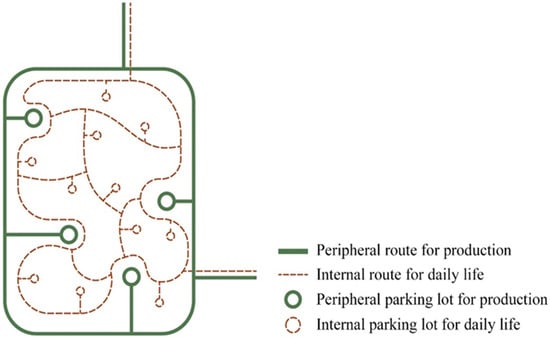
Figure 9.
Graded road structure of peripheral production route and flexible daily route.
4.3.2. Creating Shared and Contextualized Public Places That Support Adapted Use
Different from the functional and indexed public space of an urban community, the interaction between migration behavior and space shows the pursuit of flexible open space and shared space. For example, some spaces that have not been included in the public service system have become “frequent venues” for migrants’ diverse activities. Living space “occupied and transformed by rural-like living activities” or “requisitioned for production activities” occurs frequently. So, in the concrete design of public spaces, design techniques, such as accommodating multiple-function space (Figure 10), can be applied to form shared and contextualized public places that support the adapted use of rural migrants [44]. For example, the basketball square can be changed into grain-sunning ground for the autumn harvest.

Figure 10.
Multiple-function space.
4.3.3. Inlaying Semi-Public Space in Apartment Buildings
Under the current regulations, apartments strictly define the boundaries between “private” and “public” through property rights, and the transition space between the public and private sectors disappears. However, the lifestyle of rural migrants often blurs the boundaries between public and private, and their behavior tends to extend from private indoor space to outdoors, such as chatting in front of the door, stacking old furniture, drying clothes and grains in public walkways, planting fruits and vegetables on public balconies, etc., resulting in the phenomenon of semi-public spaces surrounding residential buildings being “occupied” constantly, and the boundary between public and private spaces presents a fuzzy feature. So, for functions such as housework, semi-public places in apartment buildings, such as the ground floor, roof, and outdoor spaces, can be used to conduct semi-private behaviors such as living and stacking [45] (Figure 11).
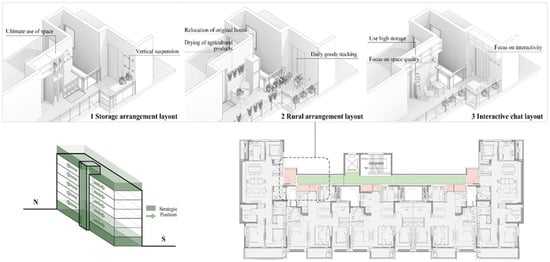
Figure 11.
Semi-public places in apartment buildings.
5. Conclusions
Previous studies on the behavior and needs of rural migrants have found that the production and living needs of rural migrants for the public space of resettlement communities present complex differentiation and dislocation. However, the planning of the public space of the resettlement community follows a single-function programming of the urban community, which does not match the needs of rural migrants, resulting in conflicts between migration and community regulation. Based on previous research results on rural migrants’ behavior and needs, this study breaks through the hermeneutic research layer on the dislocation between public space and migrants’ needs and provides a practical research transformation of the complex internal differentiation mechanism of rural migrants’ needs. This transformation is applied to planning and design. In addition, this study comprehensively considered the complex conditions in the transformation process, excavated the “basic–extension–potential” function item sets with different priorities for each type of migrant, utilized current building standards to complete and optimize the need research results from a single perspective of rural migration, and thus formed the function programming of resettlement community public space under the combination of multiple types of rural migrants in realistic scenarios. Furthermore, a “elastic design strategy” protocol for resettlement community public space planning was proposed by specifically focusing on two function programming aspects “medium-high” and “medium-low” urbanization resettlement communities. This kind of user-appropriate placement strategy is very important around the world, especially in China.
Notably, this study mainly used function programming based on the bottom-up perspective of migrants’ needs; however, the planning and building of resettlement communities is a complex and continuous subject influenced by different top-down objectives, such as national political orientation, policy support, and construction costs. To enhance the practicality of function programming, future research could consider a top-down management perspective to realize the combination of multiple objectives and establish a multifaceted public space planning system for resettlement communities. In addition, considering the long-lasting behaviors and needs of rural migrants from a micro-perspective of their life cycle, the function programming proposed in this study offers valuable theoretical support for the planning of resettlement community public spaces. However, from a macro-perspective of historical development spanning centuries, the changing needs of rural migrants undergo a dynamic evolutionary process, and the homogenization of residents’ characteristics within the same environment becomes an inevitable trend. Hence, the urbanization of rural migrants is inevitable. Therefore, the results of rural migrants’ needs research possess certain timeliness, which makes the regulations described in this study to be timely too, suggesting that continuous and in-depth exploration, practical implementation, and verification from various dimensions are necessary to properly cope with such dynamic changes and formulate long-term planning strategies for resettlement communities.
Author Contributions
Conceptualization, Z.Q.; methodology, Z.Q. and Y.H.; software, Y.H.; validation, Z.Q. and Y.H.; formal analysis, Y.H. and B.Y.; investigation, Z.Q., Y.H., B.Y. and Y.Z.; resources, Y.Z.; data curation, Y.H. and B.Y.; writing—original draft preparation, Y.H.; writing—review and editing, Z.Q.; visualization, Y.H. and B.Y.; supervision, Z.Q.; project administration, Z.W.; funding acquisition, Z.Q. and Y.Z. All authors have read and agreed to the published version of the manuscript.
Funding
This research was funded by the National Natural Science Foundation of China (52278044).
Data Availability Statement
Data supporting the reported results of rural migrants’ needs can be found at https://pan.zju.edu.cn/share/d3ae7854ce1cf3e71802ab5630, (accessed on 4 June 2023).
Acknowledgments
The authors would like to express sincere gratitude to the support received from the architecture students of Zhejiang University in collecting the data, and the assistance in the research work provided by the inhabitants of the Community L.
Conflicts of Interest
The authors declare no conflict of interest with each other in this paper. Two institutes, the College Civil Engineering and Architecture of Zhejiang University and Zhejiang Design Institute of Water Conservancy & Hydro-Electric Power Co., Ltd., have no conflicts of interest with each other in this paper.
Appendix A
A total of 125 valid questionnaires were obtained. By analyzing the curve of sample size in every average score in Figure A1 and Figure A2, two wave crests can be fined both in living need figure and production need figure. In both figures, the left wave crest represents the low need samples and the right wave crest represent high need samples, which means clustering characteristics of high and low needs for migrants were found in the production and living dimensions. Thus, further classification of the samples is needed. To explore the comprehensive differences in the production and living need dimensions of different types of samples, this study designed a three-step analysis path, comprising grouping, correlation, and construction performed with SPSS 23.0 for Windows.
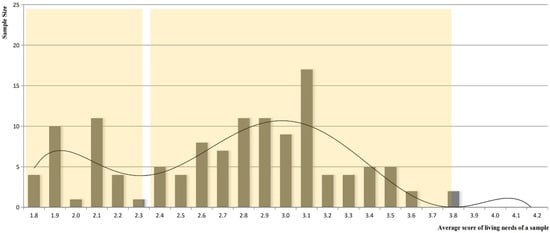
Figure A1.
Frequency distribution of the average score of one sample for living needs.
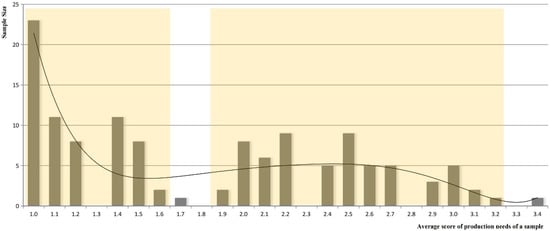
Figure A2.
Frequency distribution of the average score of one sample for production needs.
- Grouping
Based on the need results of each sample, this study divides the samples into two groups according to the needs of production and living by the systematic clustering method, where the specific methods used are the square Euclidean distance and intergroup connection. Then, using a one-way analysis of variance test, the samples are divided into high- and low-demand groups separately for production and living dimensions based on the significance of the difference in average values for each indicator. Four types of samples with different production and living need characteristics are obtained by superposition according to the high- and low-need groups in production and living. The average score of a need indicator for a certain type of migrant is the need degree for the indicator for this type of rural migrant. According to the grouping of samples, a four-quadrant decomposition model of rural migrants was constructed based on the degree of urbanization of production and living needs.
- b.
- Correlation
This study analyzed the population attribute characteristics, including gender, age, marital status, housing status, health status, education level, and labor ability, of four different types of rural migrants to further explore the internal mechanism of the differentiation of rural migrants’ production and living needs. Based on the chi-square test of a percentage value, a four-quadrant decomposition model of rural migration based on population attributes was established.
- c.
- Construction
By coupling the “decomposition model based on the urbanization degree of production and living need” with the “decomposition model of rural migration based on population attributes,” the four-quadrant model of urbanization characteristics of production and living needs of rural migrants was finally obtained. It includes four different need characteristics and different population attributes for rural migrant types: Type H-H, Type H-L, Type L-H, and Type L-L. (Figure A3).
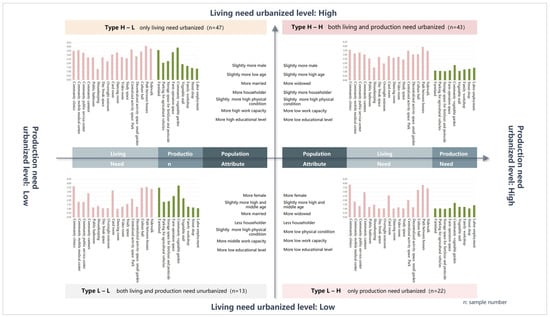
Figure A3.
Four-quadrant model for rural migrants based on production and living needs characteristics.
References
- Ajiang, C.; Shi, G. A Social Integration Study of Involuntary Migration. Chin. Sociol. Anthropol. 2006, 38, 5–18. [Google Scholar] [CrossRef]
- de Sherbinin, A.; Castro, M.; Gemenne, F.; Cernea, M.M.; Adamo, S.; Fearnside, P.M.; Krieger, G.; Lahmani, S.; Oliver-Smith, A.; Pankhurst, A.; et al. Preparing for Resettlement Associated with Climate Change. Science 2011, 334, 456–457. [Google Scholar] [CrossRef] [PubMed]
- Seth, S.; Tutor, M.V. Evaluation of Anti-Poverty Programs’ Impact on Joint Disadvantages: Insights from the Phil-ippine Experience. Rev. Income Wealth 2021, 67, 977–1004. [Google Scholar] [CrossRef]
- Cernea, M.M. Risk, Security and Reconstruction: A resettlement model. J. Hohai Univ. (Philos. Soc. Sci.) 2002, 58, 124–133. (In Chinese) [Google Scholar] [CrossRef]
- Xu, Y.; Tang, B.; Chan, E.H.W. State-led land requisition and transformation of rural villages in transitional China. Habitat Int. 2011, 35, 57–65. [Google Scholar] [CrossRef]
- Yi, Z.; Mengsha, G. Planning and practice of reservoir resettlement in new-type urbanization mode: Case of Nan’an Reservoir in Yongjia County of Wenzhou City. Yangtze River 2015, 46, 107–111. [Google Scholar] [CrossRef]
- Zhi, Q.; Yi, H.; Yue, W.; Zhu, W. Study on “Adapted Use” in Reservoir Resettlement Community—Taking Community L of Zhejiang Province as an Example. In Proceedings of the 14th International Conference on Environment-Behavior Studies, Xi’an, China, 18 October 2022. [Google Scholar]
- Yang, Y.; Qian, Y.; Zeng, J.; Wei, X.; Yang, M. Walkability Measurement of 15-Minute Community Life Circle in Shanghai. Land 2023, 12, 153. [Google Scholar] [CrossRef]
- Wan, J.; Zhao, Y.; Zhang, K.; Ma, C.; Sun, H.; Wang, Z.; Wu, H.; Li, M.; Zhang, L.; Tang, X.; et al. Healthy Community-Life Circle Planning Combining Objective Measurement and Subjective Evaluation: Theoretical and Empirical Research. Int. J. Environ. Res. Public Health 2022, 19, 5028. [Google Scholar] [CrossRef]
- Yifan, Y. From Traditional Residential Area Planning to Neighborhood Life Circle Planning. City Plan. Rev. 2019, 43, 17–22. (In Chinese) [Google Scholar]
- Shangguan, Z.; Liu, J.; Wang, M.Y.; Chen, S.; Zhang, R. Have Water Conservancy Project Resettlers in Contemporary China Really Been Lifted Out of Poverty? Re-Measurement Based on Relative Poverty and Consumption Poverty. Land 2023, 12, 169. [Google Scholar] [CrossRef]
- Xu, K.; Gao, H.; Bao, H.; Zhou, F.; Su, J. Sustainable Transformation of Resettled Communities for Landless Peasants: Generation Logic of Spatial Conflicts. Land 2021, 10, 1171. [Google Scholar] [CrossRef]
- Buchecker, M. Withdrawal from the Local Public Place: Understanding the Process of Spatial Alienation. Landsc. Res. 2009, 34, 279–297. [Google Scholar] [CrossRef]
- Xu, K.; Gao, H.; Su, J.; Bao, H.; Zhan, B.; Jiang, C.; Chen, L. Accommodation and Avoidance: Functional Conflict Theory (FCT)-Based Governance Logic of Resettled Community Conflict in China. Land 2022, 11, 1867. [Google Scholar] [CrossRef]
- Jiang, Y.; Waley, P.; Gonzalez, S. ‘Nice apartments, no jobs’: How former villagers experienced displacement and resettlement in the western suburbs of Shanghai. Urban Stud. 2018, 55, 3202–3217. [Google Scholar] [CrossRef]
- Zhou, S.; Chen, S. The Impact of the Anti-Poverty Relocation and Settlement Program on Farmers’ Livelihood: Perspective of Livelihood Space. Sustainability 2023, 15, 8604. [Google Scholar] [CrossRef]
- Zhi, Q.; Yi, H.; Yue, W.; Zhu, W. Research on the Features and Mechanism of Behavior-oriented “Adapted Use” of Resettlement Community in Town. Archit. J. 2021, 1, 114–119. (In Chinese) [Google Scholar]
- Hua, Y.; Qiu, Z.; Luo, W.; Wang, Y.; Wang, Z. Correlation between Elderly Migrants’ Needs and Environmental Adaptability: A Discussion Based on Human Urbanization Features. Int. J. Environ. Res. Public Health 2021, 18, 5068. [Google Scholar] [CrossRef]
- Cardoso, R.; Sobhani, A.; Meijers, E. The cities we need: Towards an urbanism guided by human needs satisfaction. Urban Stud. 2021, 59, 2638–2659. [Google Scholar] [CrossRef]
- Gu, T.; Yuan, J.; Li, L.; Shao, Q.; Zheng, C. Demand for community-based care services and its influencing factors among the elderly in affordable housing communities: A case study in Nanjing City. BMC Health Serv. Res. 2020, 20, 241. [Google Scholar] [CrossRef]
- Qiu, Z.; Zhang, Z.; Ye, L.; Luo, W. Building for the Elderly in North Zhejiang Rural Areas Based on the Survey and Analysis of Demands. New Archit. 2017, 1, 24–28. (In Chinese) [Google Scholar]
- Luo, W.; Qiu, Z.; Yokoyama, Y.; Zheng, S. Decision-Making Mechanism of Joint Activities for the Elderly and Children in Integrated Welfare Facilities: A Discussion Based on “Motivation–Constraint” Interaction Model. Int. J. Environ. Res. Public Health 2022, 19, 10424. [Google Scholar] [CrossRef] [PubMed]
- Li, C.; Guo, M.; Li, S.; Feldman, M. The Impact of the Anti-Poverty Relocation and Settlement Program on Rural Households’ Well-Being and Ecosystem Dependence: Evidence from Western China. Soc. Nat. Resour. 2021, 34, 40–59. [Google Scholar] [CrossRef]
- He, W. “Application” of “Applied Hermeneutics”: Taking Gadamer’s “Idea of the University” as an Example. J. Soc. Sci. 2022, 7, 38–48. (In Chinese) [Google Scholar]
- Lambek, M. The Wrong Question? Philosophies 2023, 8, 38. [Google Scholar] [CrossRef]
- van Nes, A.; Yamu, C. Exploring Challenges in Space Syntax Theory Building: The Use of Positivist and Hermeneutic Explanatory Models. Sustainability 2020, 12, 7133. [Google Scholar] [CrossRef]
- Lei, Y.; Finlayson, C.M.; Thwaites, R.; Shi, G.; Cui, L. Using Government Resettlement Projects as a Sustainable Adaptation Strategy for Climate Change. Sustainability 2017, 9, 1373. [Google Scholar] [CrossRef]
- Li, Y.; Feng, X. Influence of Housing Resettlement on the Subjective Well-Being of Disaster-Forced Migrants: An Empirical Study in Yancheng City. Sustainability 2021, 13, 8171. [Google Scholar] [CrossRef]
- Kempa, D.; Karrasch, L.; Schlurmann, T.; Prominski, M.; Lojek, O.; Schulte-Güstenberg, E.; Visscher, J.; Zielinski, O.; Goseberg, N. Design and Insights Gained in a Real-World Laboratory for the Implementation of New Coastal Protection Strategies. Sustainability 2023, 15, 4623. [Google Scholar] [CrossRef]
- Yingsheng, J. The international and external evidences: New perspective of sociological research method. J. Northwest Norm. Univ. (Soc. Sci.) 2021, 58. (In Chinese) [Google Scholar] [CrossRef]
- Otsuki, T. Residential studies and architectural planning. Dly. Life Cult. 2015, 1, 177–181. (In Japanese) [Google Scholar]
- Nishide, K. The Foundation of Building Planning, Mathematical Engineering; Scientific Publishing: Tokyo, Japan, 2009. (In Japanese) [Google Scholar]
- Lu, Y.; Ahmad, Y. Heritage Protection Perspective of Sustainable Development of Traditional Villages in Guangxi, China. Sustainability 2023, 15, 3387. [Google Scholar] [CrossRef]
- Zhang, Z.; Qiu, Z. The usage pattern and spatial preference of community facilities by elder people in rural environments. J. Hous. Built Environ. 2020, 35, 661–678. [Google Scholar] [CrossRef]
- Qiu, Z.; Wang, Y.; Bao, L.; Yun, B.; Lu, J. Sustainability of Chinese Village Development in a New Perspective: Planning Principle of Rural Public Service Facilities Based on “Function-Space” Synergistic Mechanism. Sustainability 2022, 14, 8544. [Google Scholar] [CrossRef]
- Qian, Z. Displaced villagers’ adaptation in concentrated resettlement community: A case study of Nanjing, China. Land Use Policy 2019, 88, 104097. [Google Scholar] [CrossRef]
- Yang, Q.; Ley, D. Residential relocation and the remaking of socialist workers through state-facilitated urban redevelopment in Chengdu, China. Urban Stud. 2018, 56, 2480–2498. [Google Scholar] [CrossRef]
- Xiaoling, D. On-Site Investigation Methodology in Urban Design-from the Perspective of Environment-Behavior Studies; Tongji University: Shanghai, China, 2010; pp. 3–7. (In Chinese) [Google Scholar]
- Tay, L.; Diener, E. Needs and subjective well-being around the world. J. Personal. Soc. Psychol. 2011, 101, 354–365. [Google Scholar] [CrossRef]
- Albarracin, D.; Wyer, R.J. The cognitive impact of past behavior: Influences on beliefs, attitudes, and future behavioral decisions. J. Pers. Soc. Psychol. 2000, 79, 5–22. [Google Scholar] [CrossRef]
- Zhou, L.; Xiong, L. Evolution of the physical and social spaces of ‘village resettlement communities’ from the production of space perspective: A case study of Qunyi community in Kunshan. Int. J. Environ. Res. Public Health 2019, 16, 2980. [Google Scholar] [CrossRef]
- Halmdienst, N.; Radhuber, M.; Winter-Ebmer, R. Attitudes of elderly Austrians towards new technologies: Communication and entertainment versus health and support use. Eur. J. Ageing 2019, 16, 513–523. [Google Scholar] [CrossRef]
- Song, J. Study of “Adapted Use” and Design Optimization in Zhejiang Reservoir Resettlement Community Based on Demand Orientation; Zhejiang University: Hangzhou, China, 2019; pp. 33–34. (In Chinese) [Google Scholar]
- Zhao, W.; Zou, Y. Un-gating the gated community: The spatial restructuring of a resettlement neighborhood in Nanjing. Cities 2017, 62, 78–87. [Google Scholar] [CrossRef]
- Shi, J.; Hu, X.; Guo, X.; Lian, C. Risk Information Seeking Behavior in Disaster Resettlement: A Case Study of Ankang City, China. Int. J. Environ. Res. Public Health 2020, 17, 7352. [Google Scholar] [CrossRef] [PubMed]
Disclaimer/Publisher’s Note: The statements, opinions and data contained in all publications are solely those of the individual author(s) and contributor(s) and not of MDPI and/or the editor(s). MDPI and/or the editor(s) disclaim responsibility for any injury to people or property resulting from any ideas, methods, instructions or products referred to in the content. |
© 2023 by the authors. Licensee MDPI, Basel, Switzerland. This article is an open access article distributed under the terms and conditions of the Creative Commons Attribution (CC BY) license (https://creativecommons.org/licenses/by/4.0/).